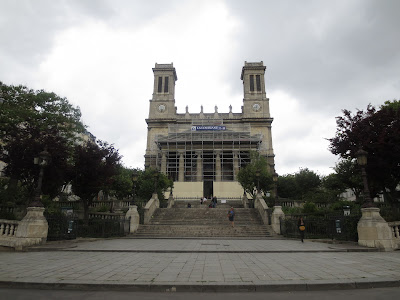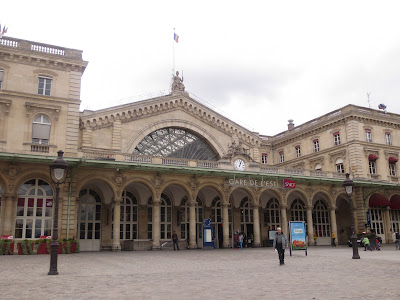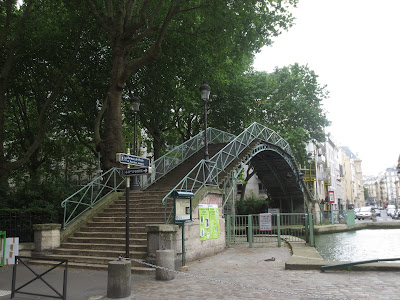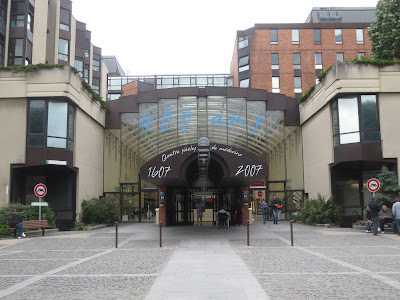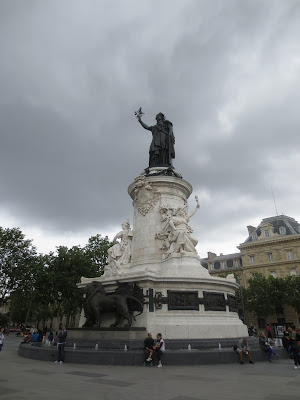Even though my goal was similar to that accomplished during my visit of the 9th ‒ ask 50 groups comprised of both men and women if they came from the capital of a given American state ‒, I had to deal with certain difficulties that were virtually absent the last time around. First of all, there was the rain, which stopped by on three occasions to disrupt my flow. In addition, I encountered some serious mental obstacles, especially when I doubted myself and consequently hesitated to approach several groups. To get myself to persevere through these trying moments, I sometimes recalled a statement that I had heard last week from Miami Heat forward/center Chris Bosh. He said the following during his press conference after the Heat lost Game 5 of the NBA Finals against San Antonio Spurs: "When you are overthinking too much, you get into your own way". Lovely.
It took me more than three hours ‒ or what seemed like an eternity ‒ but I made it to Cheyenne, Wyoming, otherwise known as State Capital Number 50.
The following are the sites that I discovered along the way.
Gare du Nord
Paris' premier train station (gare) is also one of the busiest in Europe, if not the busiest. It's where you can catch trains to England, Belgium, Germany, the Netherlands, and Northern France.
This is where the afternoon got started. And the kick-off was certainly not smooth. I needed to approach two groups before I left the site, and I ended up hesitating on the first candidate, then the next, then the next, all the while walking around the corner of the train station. I even thought about tanking the operation as I held myself scoreless. I eventually mustered enough courage to push through, and after the first approach, I was good to go.
Eglise Saint-Vincent-de-Paul
A church (église) built during 1824 to 1844 on the site of the ancient Saint-Lazare prison enclosure.
Gare de l'Est
Another of Paris' six main train stations, located close to Gare du Nord, this one caters to several destinations east of Paris, including Reims, Strasbourg, Munich, Frankfurt, Luxembourg.
Jardin Villemin
A garden (jardin) located on the site of a former military hospital of the same name.
Upon entering the garden, I saw a group of 20 or so people having a picnic in a semi-enclosed corner. Some were eating, and others were playing pétanque. The garden being virtually empty of groups at that time of day, I decided to go say hello to the picnickers. This was not without some anxiety.
As soon as I walked into their space, a guy from the group came to greet me as I was about to start my routine. Before I could finish, he stopped me, lashing out a barrage of statements, sometimes in French, sometimes in English, that left me a little lost: "I don't speak English. I speak Japanese, you? Chinese? I speak Chinese. I am Arab. You speak Arab? I don't like English people." He was being totally difficult, or maybe it was simply his nature, but I didn't budge. Even though I came to expect that he would not understand my question, I still had to ask it though, and in English: "Are you from Annapolis, Maryland?" Without a surprise, his response was incoherent. But he created a wonderful opening for me to escape. Facing me, he pulled out his hand inviting me for a handshake and, at the same moment, turned his torso away slightly, as if he was posing for someone taking a picture in front of us. Then he shouted, "Photo!", and amusingly enough, having understood what was going on, I posed. He smiled at me, after which he went to join his group. Suddenly alone, I collected myself and left the area.
The least ‒ and the only thing ‒ that I could say that was my mission had been accomplished.
Canal Saint-Martin
On the border of Jardin Villemin lies this 4.5-kilometer long canal, whose course through the 10th arrondissement is open or visible (as opposed to underground, like its course through the neighboring 11th). Its construction began in 1805 and lasted until 1825, due to difficulties of carrying out such an extensive work in an already very urban city. The canal is home to 9 locks and can be crossed via 2 movable bridges, 2 fixed bridges, and 6 footbridges.
It was here that I first witnessed the mechanism of locks four summers ago. I thought that it was the coolest thing to experience.
During my stroll, I noticed that there were a lot of English speakers around the canal. It was also a Sunday afternoon. In addition, there seemed to be many trendy places to eat and drink in the neighborhood, and the mood appeared to be cheerful, in spite of the visiting rain. I suppose that it all attests to the charm of this popular area. Some people undoubtedly find it romantic.
As far as Operation 50 First States is concerned, I encountered my most serious doubts along the canal. While groups of people were frequent on my path, I just was not sure how to manage the situation. I was asking myself a lot of questions: "Should I approach that family with kids? The pregnant woman with a stroller who's accompanied by her husband? This guy clearly kicking game to the girl walking with him? That group of teenagers? What if those people coming up are Americans? Yes, I was right, they are Americans, good thing that I did not approach them. But it would have been funny if I had, right? This is just too weird. Not to mention daft." Yet all I needed to do was to ask two groups the same question that I had already asked more than a thousand times, and then I could leave the canal for good. It took a decent while and some repeated steps, but I eventually pulled through. Go me!
Hôpital Saint-Louis
A hospital that specializes in dermatology, as well as hematology, oncology, and plastic surgery.
 |
| Quadrilatère Saint-Louis |
 |
| Quadrilatère Saint-Louis |
 |
| Exit to Place du Docteur Alfred Fournier |
This hospital has one of the aesthetically pleasing grounds that I have ever seen in a Parisian hospital. Then again, I have not been to many hospitals in Paris.
As I walked on a sidewalk across from the hospital, I noticed a young couple headed in my direction. Since it was time to ask a guy the question, I went to the guy of the couple and asked: "Are you from Trenton, New Jersey?" I found him smiling after he heard the question. Still cheerful, he replied: "No. You thought I was from there?" I then conceded, saying: "No. I was just bored." He let out a bigger smile, and the girl who was with him was amused. We went our different ways afterwards. It was the highlight of the my day.
Place de la République
This square (place), which borders the 3rd, 10th, and 11th arrondissements, is one of the largest of Paris at more than 33,000m². It is located at the site occupied in the 14th century by the Porte du Temple stronghold, at the Wall of Charles V, one of the seven former city walls surrounding Paris. Formerly named Place du Château d'Eau, the square became, in 1883, home to a large monument symbolizing values dear to the Republic : liberty, equality, fraternity. Each of these values is represented on the monument by a statue fixed to a central column, on which stands a "Statue de la République" in the form of Marianne, the national emblem of France.
Today, the square is popular meeting place in Paris as well as a top site for demonstrations and protests.
It was only during my stroll that I discovered the new look of Place de la République, which was inaugurated on June 16. The square is now much more pedestrian than it was during my previous visit. I do not remember having seen a grand square in Paris so accessible on foot before. The atmosphere was especially playful, with residents and tourists everywhere. Until the rain revisited and the square suddenly became vacant (see above).
Porte Saint-Martin
A monument commissioned by Louis XIV to commemorate his military victories, this 18-meter high triumphal arch built in limestone and marble was erected on the site of a former gate of the Wall of Charles V.
Passage Brady
This passage, constructed in 1828, is one of two iron-and-glass covered arcades located in the arrondissement. It links Rue du Faubourg-Saint-Denis to Rue du Faubourg-Saint-Martin, and is famous its numerous Indian, Pakistani, and Bangladeshi restaurants.
This may be where I had my first Indian meal in Paris, more than 10 years ago.
One thing that I quickly sensed upon entering this 216-meter long passageway is that the groups of both men and women that I crossed paths with would be rare. And I didn't want to pace the passage back and forth waiting for the right candidates to show up; that would only attract the suspicion of restaurant attendants doing their best to entice visitors to try their food, and I didn't want that. So I had no luxury to let a group pass me by; I had to give it a go without hesitation. I carried out my duties without problems for the two couples that I passed. Concerning the second one, I left the guy of the couple confused after asking the question ("Are you from Charleston, West Virginia?"), causing a nearby restaurant patron to head towards us, as if I was asking for directions. As soon as I saw him coming, I asked the guy hurriedly: "Are you from there or not?" Still looking confused, he nevertheless replied "No" and instantly we went our separate routes. The experience was quite akin to a transaction: I got straight to the point, certainly without trying to lighten up the mood for the few seconds that it lasted.
Porte Saint-Denis
Like its neighbor only 200m south east on Boulevard Saint-Denis, Porte Saint-Denis was built in the 17th century in honor of the victories of Louis XIV and is situated on the old site of the wall of Charles V. Both triumphal arches even bear the same bronze inscription: LUDOVICO MAGNO (To Louis the Great). However, Porte Saint-Denis is taller (25 meters) and was designed by an architect different from the one who designed Porte Saint-Martin.
Below are the "bonus sites" ‒ other interesting things that I saw ‒ that did not make it to the Top 10.
 |
| Eglise Saint-Laurent |
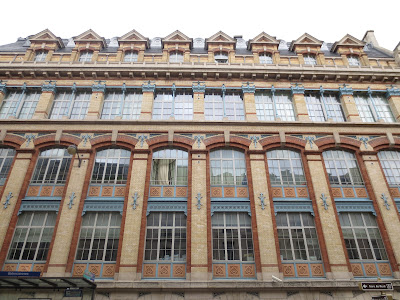 |
| Building facade on Rue du Faubourg-Saint-Denis |
 |
| Antoine & Lili own this block |
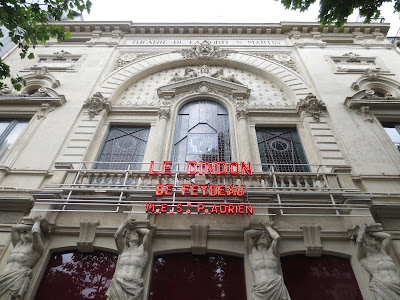 |
| Théâtre de la Porte Saint-Martin |

